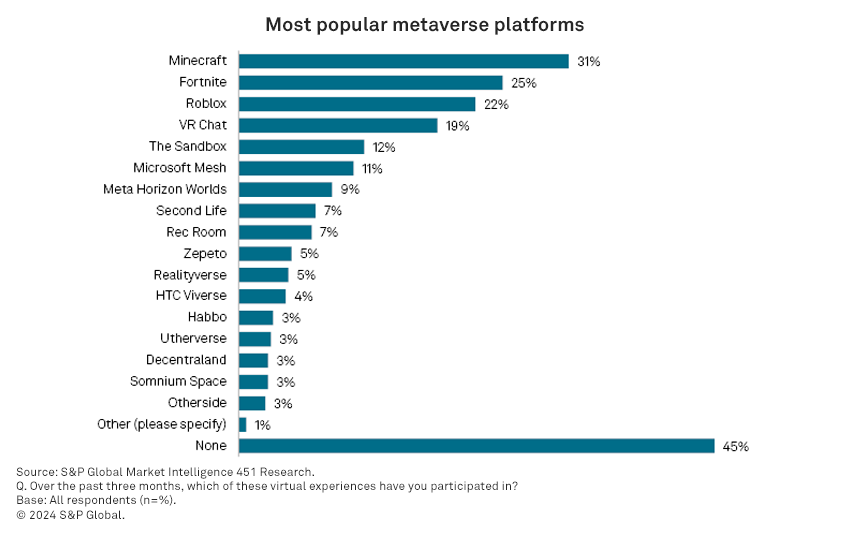
Source: Bradley Hook/Pexels.
The metaverse is no longer just a playground for the young; it’s quickly becoming a space where adults are actively engaging. According to a recent S&P Global survey, over half of adult consumers worldwide have interacted with a metaverse-leaning platform in the past three months. However, the true metaverse—a single, shared, immersive, and persistent 3D virtual space—remains a few years away.
Popular metaverse platforms
The survey highlighted the most popular metaverse-leaning platforms among adults, which are as follows:
- Minecraft leads the pack, with nearly one-third of respondents reporting engagement in the past three months.
- Fortnite follows closely, engaging one-quarter of adults.
- Roblox also shows significant traction, with 22.4% of adults participating.
These platforms are popular due to their interactive and immersive environments, which allow users to create, explore, and socialize in virtual worlds.
Interestingly, the survey also revealed that while these platforms are popular globally, there are regional differences. In North America, Minecraft remains the most popular, but the gap between its two closest competitors, Fortnite and Roblox, is narrower compared to other regions. This suggests regional preferences and the potential for different marketing strategies to boost engagement.

Key use cases
Exploring new places virtually is one of the top use cases for metaverse experiences. This allows users to visit destinations and environments without leaving their homes, providing a unique way to experience new cultures and landscapes. Playing video games remains a significant draw, given the immersive and interactive nature of these platforms. Games like Minecraft, Fortnite, and Roblox offer complex, engaging experiences that attract a wide audience.

Interacting with friends in a virtual environment also appeals to many, providing a social aspect to the metaverse. These platforms offer various ways for users to connect, collaborate, and compete with friends, making the experience more engaging and enjoyable. However, viewing movies and TV shows is an underserved area. Despite being the second-most popular potential use case, most top platforms do not fully integrate streaming video. Notably, Apple’s Vision Pro headset and Meta’s Quest headsets are beginning to incorporate more media consumption features, hinting at future developments in this space.
Barriers to entry
For those not yet engaged in the metaverse, several barriers exist. A primary concern is the lack of information about what the metaverse offers. Many potential users are unsure of the benefits and experiences available, indicating a need for better communication and education from platform holders.
Safety concerns about the technology itself also deter potential users. This includes worries about privacy and data collection, as well as standards of conduct within these virtual environments. More than half of all survey takers expressed concerns about privacy and data collection, highlighting the need for robust security measures and transparent data practices.
User security is another critical issue. Ensuring that users feel safe and secure while interacting in the metaverse is paramount. This includes protecting personal information and safeguarding against malicious activities. Additionally, concerns about the security of payment or transaction data also play a role in holding back non-users. Establishing secure and reliable payment systems is essential to building trust and encouraging broader adoption.
Future trends
Looking ahead, a majority of respondents believe the metaverse will become widely used within the next three years, with a plurality pointing toward the two- to three-year range. This optimism suggests that while the metaverse is still in its early stages, there is significant potential for growth and development. However, the lack of interconnectivity between platforms prevents them from truly feeling like “the metaverse.” Current platforms like Roblox or Minecraft offer immersive experiences, but they are not interconnected, limiting the sense of a unified virtual space.
Streaming video integration could be the next frontier for the metaverse. Platforms like Apple Vision Pro and Meta Quest headsets are already making strides in this area, incorporating more media consumption features. Walt Disney Co.’s $1.50 billion investment in Fortnite aims to bring significant film and TV IP content franchises to the platform, potentially transforming how users consume media in the metaverse.
Want insights on consumer technology trends delivered to your inbox? Join the 451 Alliance.
Want insights on IoT trends delivered to your inbox? Join the 451 Alliance.
This content may be AI-assisted and is composed, reviewed, edited and approved by S&P Global in accordance with our Terms of Service.

